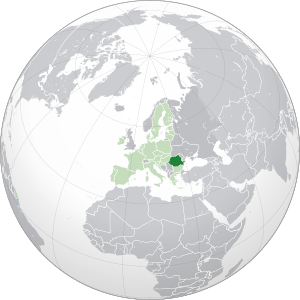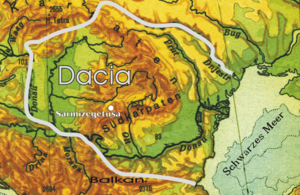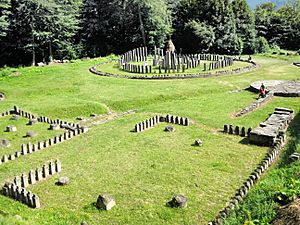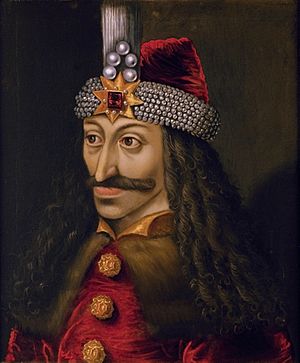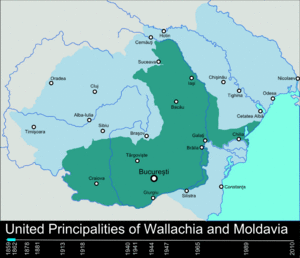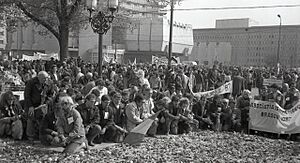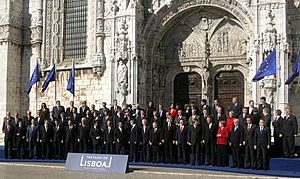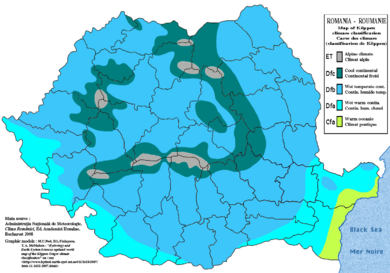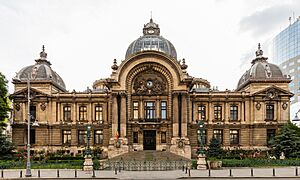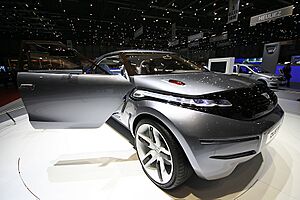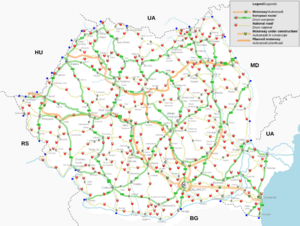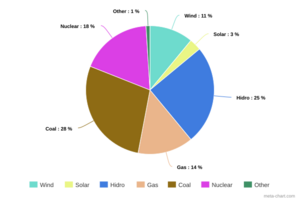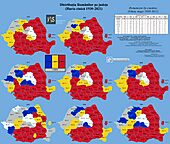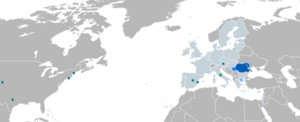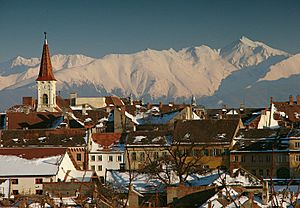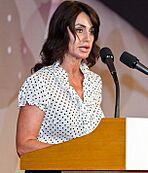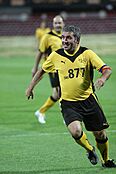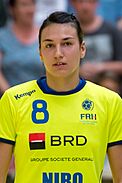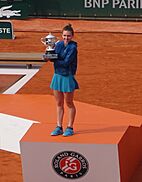Romania facts for kids
Quick facts for kids
Romania
România (Romanian)
|
|
|---|---|
|
Location of Romania (dark green)
– on the European continent (green & dark grey) |
|
| Capital and largest city
|
Bucharest 44°25′N 26°06′E / 44.417°N 26.100°E |
| Official languages | Romanian |
| Ethnic groups
(2021)
|
|
| Religion
(2021)
|
|
| Demonym(s) | Romanian |
| Government | Unitary semi-presidential republic |
| Ilie Bolojan (acting) | |
| Cătălin Predoiu (acting) | |
| Mircea Abrudean (acting) | |
| Legislature | Parliament |
| Senate | |
| Chamber of Deputies | |
| Formation | |
|
• Principality of Wallachia
|
1330 |
| 1346 | |
|
• United Principalities
|
24 January 1859 |
|
• Independence from the Ottoman Empire
|
10 May 1877 |
| 13 March 1881 | |
|
• Great Union
|
1 December 1918 |
| 30 December 1947 | |
| 8 December 1991 | |
| Area | |
|
• Total
|
238,397 km2 (92,046 sq mi) (81st) |
|
• Water (%)
|
3 |
| Population | |
|
• 2024 estimate
|
|
|
• 2021 census
|
|
|
• Density
|
79.9/km2 (206.9/sq mi) (136th) |
| GDP (PPP) | 2025 estimate |
|
• Total
|
|
|
• Per capita
|
|
| GDP (nominal) | 2025 estimate |
|
• Total
|
|
|
• Per capita
|
|
| Gini (2024) | ▼ 28.0 low |
| HDI (2023) | very high · 55th |
| Currency | Romanian leu (RON) |
| Time zone | UTC+2 (EET) |
|
• Summer (DST)
|
UTC+3 (EEST) |
| Date format | dd.mm.yyyy (CE) |
| Driving side | right |
| Calling code | +40 |
| ISO 3166 code | RO |
| Internet TLD | .ro |
Romania is a country in Central, Eastern, and Southeast Europe. It shares borders with Ukraine, Hungary, Serbia, Bulgaria, Moldova, and the Black Sea. Romania has a mostly continental climate and covers an area of about 238,397 square kilometers (92,046 sq mi). Around 19 million people live there.
Romania is the twelfth-largest country in Europe. It is also the sixth-most populated member of the European Union. The Danube river, Europe's second-longest, flows into the Danube Delta in southeastern Romania. The Carpathian Mountains cross the country from north to southwest. They include Moldoveanu Peak, which is 2,544 meters (8,346 ft) high.
Bucharest is Romania's largest city and its main financial hub. Other big cities include Cluj-Napoca, Timișoara, Iași, Constanța, and Brașov.
People have lived in the area of modern Romania since the Lower Paleolithic era. It later became the Dacian Kingdom before the Romans conquered it. The modern country of Romania was formed in 1859. This happened when Moldavia and Wallachia united under Alexandru Ioan Cuza. It became the Kingdom of Romania in 1881 under Carol I.
Romania gained its independence from the Ottoman Empire in 1877. This was officially recognized by the Treaty of Berlin. After World War I, Romania grew much larger. Transylvania, Banat, Bukovina, and Bessarabia joined the Old Kingdom. This created Greater Romania, which was its largest size ever.
In 1940, under pressure from the Axis powers, Romania lost some territories. These went to Hungary, Bulgaria, and the Soviet Union. After the 1944 Romanian coup d'état, Romania joined the Allies. After World War II, it got Northern Transylvania back through the Paris Peace Treaties.
Under Soviet control, King Michael I was forced to step down. Romania then became a socialist republic and joined the Warsaw Pact. After the 1989 Revolution, Romania started to become a liberal democracy and a market economy.
Romania is a developing country with a high-income economy. It is considered a middle power in global affairs. It is a unitary republic with a multi-party system and a semi-presidential representative democracy. Romania is home to 11 UNESCO World Heritage Sites. It has become a popular place for tourists, with 14 million foreign visitors in 2024.
Romania is a major exporter of cars and vehicle parts. It is also becoming known as a technology hub. It has some of the fastest internet speeds in the world. Romania is a member of many international groups. These include the European Union, NATO, and the BSEC.
Contents
Origin of the Name Romania
The name Romania comes from the Romanian word Român. This word comes from the Latin word Romanus, which means "Roman". During World War II, English texts sometimes used the word Rumania. This came from the French word Roumanie.
History of Romania
Ancient Times in Romania
People lived in the area of Romania about 40,000 years ago. These are the oldest known Homo sapiens remains in Europe. Farming began in the 6th millennium BC. Early salt production started between 5000 and 4000 BC. The first large settlements, like "proto-cities," were bigger than 800 acres.
The Cucuteni–Trypillia culture was important in ancient Europe. It existed from about 5500 to 2750 BC. During its middle period (4000 to 3500 BC), this culture built very large settlements. Some had up to 3,000 buildings and possibly 20,000 to 46,000 people. Fortified settlements appeared around 1800 BC. This shows that Bronze Age societies were often at war.
Greek colonies were set up on the Black Sea coast in the 7th century BC. They became important trading places with local tribes. The Getae and Dacians were major groups in the region. Burebista was the first Dacian ruler to unite these tribes around 55-44 BC. His kingdom fell apart after he was killed.
The Romans arrived in Dacia during Burebista's time. They conquered Dobruja in 46 AD. Dacia was united again under Decebalus around 85 AD. He fought the Romans for many years. However, the Roman army defeated his troops in 106 AD. Emperor Trajan made parts of Dacia into a new Roman province called Roman Dacia.
The Romans brought many settlers to the province. People enjoyed peace and wealth in the 2nd century. Many historians believe that the native Dacians and Roman settlers lived together. This was the first step in the creation of the Romanian people.
Tribes like the Carpians and Goths attacked Dacia from the 210s. The Romans could not stop them. Emperor Aurelian ordered the Roman army to leave the province in the 270s. Many Latin-speaking people likely stayed behind. Dobruja remained part of the Roman Empire until the early 7th century.
Middle Ages in Romania
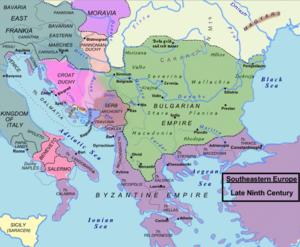
The Goths moved into the Lower Danube region from the 230s. They forced local people to leave or accept their rule. The Huns invaded in 376, ending the Goths' rule. New groups of people moved into the area. The Huns' empire fell in 454. The Gepids then took over the former Dacia province.
Many place names in Romania are of Slavic origin. This shows that many Slavic-speaking people lived there. The first Slavic groups settled in Moldavia and Wallachia in the 6th century. They settled in Transylvania around 600. The Avars defeated the Gepids around 570. The Bulgars came from the European Pontic steppe and took over the Lower Danube region in 680.
After the Avar empire fell around 790, the First Bulgarian Empire became powerful. It controlled lands up to the Tisa river. The Bulgarian Empire had a mix of Bulgars, Slavs, and Vlachs (Romanians). Slavic culture became more common among the Bulgar leaders in the 9th century. Salt mining began in Transylvania around 830. Old Church Slavonic became the language for church services in 893. The Vlachs also used this language for their services.
The Magyars (Hungarians) took control of the steppes north of the Lower Danube in the 830s. However, the Bulgarians and Pechenegs forced them to move to the lowlands along the Middle Danube around 894. Later writings mention the Magyars fighting three dukes for Banat, Crișana, and Transylvania. These writings also list many peoples living there, including Slavs, Bulgarians, Vlachs, and Székelys. Historians still discuss how accurate these old stories are.
Byzantine missionaries spread Christianity in the lands east of the Tisa from the 940s. Byzantine troops took over Dobruja in the 970s. Stephen I, the first king of Hungary, supported Western European missionaries. He defeated local leaders and set up Roman Catholic bishoprics in Transylvania and Banat in the early 11th century.
Transylvania became an important border area for the Kingdom of Hungary. The Székelys, a group of free warriors, settled in central Transylvania around 1100. They moved to the eastern parts around 1200. German settlers, ancestors of the Transylvanian Saxons, arrived in the 1150s. A royal official called a voivode ruled Transylvanian counties from the 1170s. However, the Székely and Saxon areas were not under the voivodes' control.
Old royal documents mention "Vlachs' land" in southern Transylvania in the early 13th century. This shows that there were independent Romanian communities. Papal letters mention Orthodox leaders among Romanians in Muntenia in the 1230s. Also in the 13th century, the Republic of Genoa set up trading posts on the Black Sea, including Calafat and Constanța.
The Mongols caused great destruction during their invasions in 1241 and 1242. The Golden Horde became the main power in Eastern Europe. However, Hungarian land grants show that local Vlach rulers were under the king's authority in 1247. Basarab I of Wallachia united the Romanian areas between the southern Carpathians and the Lower Danube in the 1310s. He defeated the Hungarian army and made Wallachia independent in 1330.
The second Romanian principality, Moldavia, became fully independent under Bogdan I around 1360. A local family ruled the Despotate of Dobruja in the late 14th century. But the Ottoman Empire took over this area after 1388.
Princes Mircea I, Vlad III of Wallachia, and Stephen III of Moldavia fought to keep their countries independent from the Ottomans. Most Wallachian and Moldavian princes paid regular taxes to the Ottoman sultans from 1417 and 1456. John Hunyadi, a military leader of Romanian origin, defended the Kingdom of Hungary until his death in 1456.
High taxes made Transylvanian peasants angry, and they rebelled in 1437. But Hungarian nobles and Saxon and Székely leaders worked together to stop the revolt. This alliance, called the Union of the Three Nations, helped govern Transylvania. Orthodox Romanian leaders were not part of this Union.
Early Modern Times and National Awakening
The Kingdom of Hungary fell apart, and the Ottomans took parts of Banat and Crișana in 1541. Transylvania and Maramureș, along with other parts of Banat and Crișana, became a new state. This was the Principality of Transylvania, under Ottoman control. The Reformation spread, and four Christian groups were officially recognized in 1568. These were Calvinism, Lutheranism, Unitarianism, and Roman Catholicism. The Orthodox faith of Romanians was only tolerated, even though they were a large part of the population.
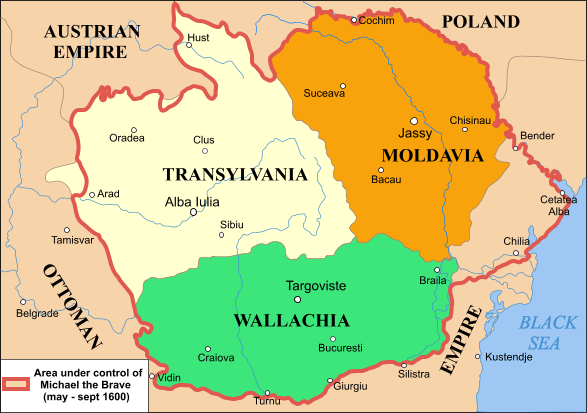 The princes of Transylvania, Wallachia, and Moldavia joined a group against the Ottoman Empire in 1594. The Wallachian prince, Michael the Brave, united the three principalities under his rule in May 1600. Other powerful countries forced him to step down in September. But he became a symbol for the idea of uniting all Romanian lands in the 19th century.
The princes of Transylvania, Wallachia, and Moldavia joined a group against the Ottoman Empire in 1594. The Wallachian prince, Michael the Brave, united the three principalities under his rule in May 1600. Other powerful countries forced him to step down in September. But he became a symbol for the idea of uniting all Romanian lands in the 19th century.
Even though the princes still paid tribute to the Ottomans, some strong leaders made their countries more independent. These included Gabriel Bethlen of Transylvania, Matei Basarab of Wallachia, and Vasile Lupu of Moldavia.
Armies from the Holy League drove the Ottoman troops out of Central Europe between 1684 and 1699. The Principality of Transylvania then became part of the Habsburg monarchy. The Habsburgs supported the Catholic Church. They convinced Orthodox Romanian leaders to join the Roman Catholic Church in 1699. This union made Romanian thinkers feel more connected to their Roman heritage. The Orthodox Church was only restored in Transylvania after revolts in 1744 and 1759.
Princes Dimitrie Cantemir of Moldavia and Constantin Brâncoveanu of Wallachia made alliances against the Ottomans. But they were removed from power in 1711 and 1714. The sultans then appointed Greek merchants from Istanbul to rule Moldova and Wallachia. These "Phanariot" princes taxed people heavily and got rid of the army. Other countries took advantage of this. The Habsburg Monarchy took Bukovina in 1775. The Russian Empire took Bessarabia in 1812.
A census in 1733 showed that Romanians were the largest ethnic group in Transylvania. But laws still treated them as "tolerated" or "admitted." The Uniate bishop, Inocențiu Micu-Klein, asked for Romanians to be recognized as a privileged group. He was forced to leave the country. In 1791, Romanian leaders asked for more rights for Transylvanian Romanians. But the government refused their requests.
The Treaty of Küçük Kaynarca in 1774 allowed Russia to protect Moldavia and Wallachia. In 1821, a Wallachian nobleman, Tudor Vladimirescu, led a revolt against the Ottomans. But he was killed by Greeks. After another war with Russia, the Treaty of Adrianople in 1829 made Moldavia and Wallachia more independent.
Leaders of the 1848 revolutions in Moldavia and Wallachia wanted to free the peasants and unite the two areas. But Russian and Ottoman troops stopped their revolt. The Wallachian revolutionaries were the first to use the blue, yellow, and red tricolor as their national flag. In Transylvania, most Romanians supported the government against Hungarian revolutionaries.

Independence and Monarchy
The Treaty of Paris in 1856 placed Moldavia and Wallachia under the protection of major European powers. Special meetings in Moldavia and Wallachia asked for the two areas to unite. The major powers allowed Alexandru Ioan Cuza to be elected as their ruler in January 1859. The united areas officially became Romania on 21 February 1862.
Cuza's government made changes, like taking land from monasteries and reforming farming. But a group of politicians forced him to step down in February 1866. Cuza's replacement, a German prince named Karl of Hohenzollern-Sigmaringen (Carol I), was elected in May. The first constitution of Romania was adopted that same year.
The major powers recognized Romania's full independence at the Congress of Berlin. Carol I was crowned king in 1881. Romania also gained the Danube Delta and Dobruja. Even though Romanian scholars wanted to unite all Romanians into a Greater Romania, the government did not openly support these ideas.
Transylvanian Romanians and Saxons wanted Transylvania to remain separate within the Habsburg Monarchy. But the Austro-Hungarian Compromise united the province with Hungary in 1867. Romanian politicians strongly opposed Hungarian efforts to make Hungarian the main language. Leaders of the Romanian National Party suggested making Austria-Hungary a federation. Romanian thinkers also created groups to promote the Romanian language.
World Wars and Greater Romania
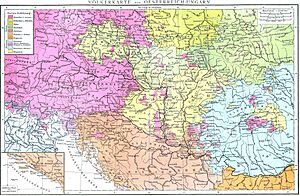
Romania secretly joined an alliance with Germany, Austria-Hungary, and Italy in 1883. This was because they feared Russia. But public opinion in Romania was against Austria-Hungary. Romania took Southern Dobruja from Bulgaria in the Second Balkan War in 1913. Germany and Austria-Hungary supported Bulgaria, which made Romania closer to France, Russia, and the United Kingdom.
Romania stayed neutral when World War I started in 1914. But Prime Minister Ion I. C. Brătianu began talks with the Allied Powers. After they promised Romanian-majority territories from Austria-Hungary, Romania joined the war against the Central Powers in 1916. German and Austrian-Hungarian troops defeated the Romanian army. They occupied three-quarters of the country by early 1917.
After the October Revolution in Russia, Romania's ally became an enemy. Romania was forced to sign a harsh peace treaty with the Central Powers in May 1918. But Russia's collapse also allowed Bessarabia to unite with Romania. King Ferdinand mobilized the Romanian army again for the Allied Powers. This was one day before Germany surrendered on 11 November 1918.
Austria-Hungary quickly broke apart after the war. The General Congress of Bukovina declared its union with Romania on 28 November 1918. The Grand National Assembly declared the union of Transylvania, Banat, Crișana, and Maramureș with the kingdom on 1 December. Peace treaties set the new borders in 1919 and 1920. But the Soviet Union did not accept the loss of Bessarabia.
Romania reached its largest size, growing from 137,000 to 295,000 square kilometers (53,000 to 114,000 sq mi). A new voting system gave all adult men the right to vote. Between 1918 and 1921, farming reforms turned the country into a "nation of small landowners." Gender equality was a principle, but women could not vote or run for office. Calypso Botez started the National Council of Romanian Women to promote women's rights.
Romania was a country with many ethnic groups, about 30% minorities. But the new constitution in 1923 declared it a single national state. Minorities could have their own schools. However, Romanian language, history, and geography could only be taught in Romanian.
Farming was still the main part of the economy. But some industries grew, like coal, oil, metals, and cosmetics. In 1930, Romania produced 5.8 million tons of oil, ranking sixth in the world. Two parties, the National Liberal Party and the National Peasants' Party, controlled politics. But the Great Depression in Romania caused big changes in the 1930s.
Democratic parties faced problems from the fascist and anti-Semitic Iron Guard. King Carol II also became more authoritarian. The King issued a new constitution and banned political parties in 1938. He replaced the parliament with a royal dictatorship.

The 1938 Munich Agreement made King Carol II believe that France and the United Kingdom could not protect Romania. Germany needed Romanian oil and farm products for its war plans. The two countries made a deal about their economies in 1939. But the King could not get Adolf Hitler to promise to protect Romania's borders.
Romania was forced to give Bessarabia and Northern Bukovina to the Soviet Union on 26 June 1940. It also gave Northern Transylvania to Hungary on 30 August, and Southern Dobruja to Bulgaria in September. After these losses, the King had to step down on 6 September. His young son, Michael I, became king. Romania became a National Legionary State led by General Ion Antonescu. Antonescu signed an agreement with Germany, Italy, and Japan on 23 November. The Iron Guard tried to overthrow Antonescu, but he stopped them with German help. He then started a military dictatorship in early 1941.

Romania joined World War II after Germany invaded the Soviet Union in June 1941. Romania got Bessarabia and Northern Bukovina back. The Germans put Transnistria (land between the Dniester and Dnieper rivers) under Romanian control. Romanian and German troops killed many local Jews and Roma people in these areas. Most Jewish people in other parts of Romania survived, but their rights were limited.
After the Allied agreement with Italy in September 1943, Romania became the second Axis power in Europe. In March 1944, Germany occupied Hungary. About 132,000 Jews from Northern Transylvania were sent to death camps with Hungarian help.
After the Soviet victory in the Battle of Stalingrad in 1943, Iuliu Maniu, an opponent of Antonescu, talked secretly with British diplomats. They said Romania needed to make peace with the Soviet Union. To work together against Antonescu, several parties formed the National Democratic Bloc. This included the National Liberal, National Peasants', Social Democratic, and Communist parties.
After a successful Soviet attack, young King Michael I ordered Antonescu's arrest on 23 August 1944. He appointed a new government from the National Democratic Bloc. Romania switched sides in the war. Nearly 250,000 Romanian troops joined the Red Army against Hungary and Germany. However, Joseph Stalin saw Romania as a Soviet-controlled territory. In March 1945, Stalin's deputy told the King to make the Communist candidate, Petru Groza, the prime minister.
The Romanian government in Northern Transylvania was soon restored. Groza's government made farming reforms. In February 1947, the Paris Peace Treaties confirmed that Northern Transylvania returned to Romania. But they also allowed Soviet army units to stay in the country.
Communist Rule in Romania

During the Soviet occupation of Romania, the Communist-led government held elections in 1946. They unfairly won with a fake 70% majority. This quickly made them the main political power. Gheorghe Gheorghiu-Dej, a Communist party leader, became Romania's first Communist leader. In February 1947, he and others forced King Michael I to step down and leave the country. Romania was then declared a "people's republic."
Romania remained under direct Soviet military and economic control until the late 1950s. During this time, the Soviet Union took many of Romania's natural resources. In 1948, the state took over private businesses and organized farms into large collective units. Until the early 1960s, the government limited people's freedoms. They stopped any opposition with the help of the Securitate, Romania's secret police.
The government launched campaigns to remove "enemies of the state." Many people were deported, exiled, or sent to forced labor camps and prisons. However, the anti-communist resistance was one of the strongest and longest-lasting in Eastern Europe. A 2006 report estimated that two million people were directly affected by the Communist government's actions.
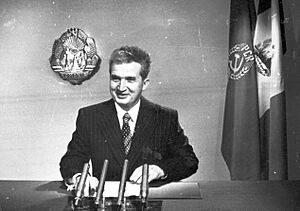
In 1965, Nicolae Ceaușescu came to power. He started to lead Romania's foreign policy more independently from the Soviet Union. Romania was the only Warsaw Pact country that refused to join the Soviet-led invasion of Czechoslovakia in 1968. Ceaușescu even spoke out against the action, calling it "a big mistake."
Romania was the only Communist state to keep ties with Israel after the 1967 Six-Day War. It also started diplomatic relations with West Germany that same year. Close ties with Arab countries and the Palestine Liberation Organization (PLO) allowed Romania to help with peace talks between Israel and Egypt, and Israel and the PLO.
Romania's foreign debt grew quickly from $3 billion to $10 billion between 1977 and 1981. This increased the influence of international financial groups like the International Monetary Fund (IMF) and the World Bank. Ceaușescu then started a policy to repay all foreign debt. He did this by making the population poorer and exhausting the economy. The country succeeded in paying off all its foreign government debt by 1989.
At the same time, Ceaușescu greatly increased the power of the Securitate secret police. He also created a strong cult of personality around himself. This made him very unpopular. It led to his overthrow in the violent Romanian Revolution of December 1989. Thousands of people were killed or injured during this time.
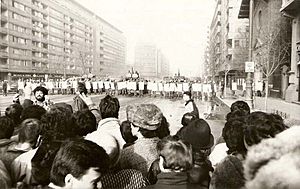
After a trial, Ceaușescu and his wife were executed by firing squad on 25 December 1989. They faced serious accusations, including causing starvation.
Contemporary Romania
After the 1989 revolution, the National Salvation Front (FSN) took power. Led by Ion Iliescu, they started some democratic and free market changes. In March 1990, there were violent clashes in Târgu Mureș due to ethnic tensions. In April 1990, a protest grew against the results of the 1990 elections. Protesters accused the FSN of having former Communists and Securitate members. Peaceful protests turned violent, leading to coal miners being called in by Iliescu. This event is known as the June 1990 Mineriad.
The FSN later split into several political parties. The most notable were the Social Democratic Party (PSD) and the Democratic Party (PDL). The PSD governed Romania from 1990 to 1996, with Ion Iliescu as president. Since then, there have been several democratic changes in government. Emil Constantinescu was elected president in 1996. Iliescu returned to power in 2000. Traian Băsescu was elected in 2004 and re-elected in 2009.
In 2009, Romania received financial help from the International Monetary Fund due to the Great Recession in Europe. In November 2014, Klaus Iohannis was elected president. He unexpectedly defeated former Prime Minister Victor Ponta. Many believe this was due to the votes of Romanians living abroad. In 2019, Iohannis was re-elected president.
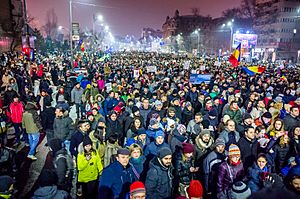
After 1989, many old state-owned companies were closed. This was mainly due to new privatization policies.
Corruption has been a big problem in Romanian politics. In November 2015, large anti-corruption protests led to the resignation of Prime Minister Victor Ponta. In 2017–2018, some of the biggest protests since 1989 happened. Over 500,000 people protested against measures that seemed to weaken the fight against corruption.
However, there have been important reforms to fight corruption. A National Anticorruption Directorate was created in 2002. Since 2014, Romania has increased its anti-corruption efforts. This has led to legal action against many high-level officials.
Joining NATO and the EU
After the Cold War, Romania built stronger ties with Western Europe and the United States. It joined NATO in 2004. Bucharest hosted the NATO summit in 2008. Romania applied to join the European Union in June 1993. It became an Associated State of the EU in 1995 and a full member on 1 January 2007.
In the 2000s, Romania had one of the fastest-growing economies in Europe. It was sometimes called "the Tiger of Eastern Europe." Living standards improved greatly. The country reduced poverty and became a working democratic state. However, Romania's development suffered during the late 2000s' recession. This led to a big drop in its economy and a budget deficit in 2009. Romania then borrowed money from the International Monetary Fund. Worsening economic conditions caused protests and a political crisis in 2012.

By late 2013, The Economist reported that Romania's economy was "booming" again. It grew by 4.1% that year. Wages were rising fast, and unemployment was lower than in Britain. Economic growth sped up as the government opened new areas to competition and investment. These included energy and telecommunications. In 2016, the Human Development Index ranked Romania as a nation with "Very High Human Development."
After economic problems in the 1990s and a free travel agreement with the EU, many Romanians moved abroad. They went to Western Europe and North America. Large communities are in Italy, Germany, and Spain. In 2016, about 3.6 million Romanians lived abroad. This was the fifth-highest number of emigrants in the world.
Geography and Climate of Romania
Romania is the largest country in Southeastern Europe. It is the twelfth-largest in Europe, covering 238,397 square kilometers (92,046 sq mi). It is located between 43° and 49° N latitude and 20° and 30° E longitude. The land is divided almost equally into mountains, hills, and plains.
The Carpathian Mountains are in the center of Romania. They have 14 mountain ranges over 2,000 meters (6,562 ft) high. The highest is Moldoveanu Peak at 2,544 meters (8,346 ft). These mountains are surrounded by the Moldavian and Transylvanian plateaus, the Pannonian Plain, and the Wallachian plains.
Romania has six types of natural areas, called ecoregions. About 47% of the country's land has natural or semi-natural ecosystems. There are almost 10,000 square kilometers (3,861 sq mi) of protected areas. These include 13 national parks and three biosphere reserves. The Danube river forms much of the border with Serbia and Bulgaria. It flows into the Black Sea, creating the Danube Delta. This delta is the second-largest and best-preserved in Europe. It is a biosphere reserve and a World Heritage Site. At 5,800 square kilometers (2,239 sq mi), the Danube Delta is Europe's largest continuous marshland. It supports 1,688 different plant species.
Romania has one of Europe's largest areas of undisturbed forest. Forests cover almost 27% of its land. In 2019, Romania ranked 90th globally for its forest health. About 3,700 plant species have been found in Romania. Of these, 23 are natural monuments, 74 are extinct, 39 are endangered, 171 are vulnerable, and 1,253 are rare.
The fauna of Romania includes 33,792 animal species. There are 33,085 invertebrate species and 707 vertebrate species. Nearly 400 unique species of mammals, birds, reptiles, and amphibians live here. This includes about 50% of Europe's (excluding Russia) brown bears and 20% of its wolves.
Climate Patterns in Romania
Romania has a continental climate with four distinct seasons. This is because it is far from the open sea. The average yearly temperature is 11°C (52°F) in the south and 8°C (46°F) in the north. In summer, average high temperatures in Bucharest reach 28°C (82°F). Temperatures over 35°C (95°F) are common in lower areas. In winter, the average high temperature is below 2°C (36°F).
Rainfall is average. Over 750 mm (30 in) per year falls only on the highest western mountains. Around Bucharest, it drops to about 570 mm (22 in). There are some regional differences. In western areas like Banat, the climate is milder with some Mediterranean influences. The eastern part of the country has a more continental climate. In Dobruja, the Black Sea also affects the region's climate.
Government and Administration
The Constitution of Romania is based on France's constitution. It was approved in a public vote on 8 December 1991. It was updated in October 2003 to match EU laws.
Romania has a multi-party democratic system. Power is divided among the legislative, executive, and judicial branches. It is a semi-presidential republic. Both the government and the president share executive duties. The president is elected by popular vote for up to two five-year terms. The president appoints the prime minister, who then appoints the Council of Ministers.
The legislative branch is the Parliament. It has two parts: the Senate and the Chamber of Deputies. Members are elected every four years. The Parliament meets at the Palace of the Parliament.
The justice system is separate from the other government branches. It has a system of courts, with the High Court of Cassation and Justice as the highest court. There are also courts of appeal, county courts, and local courts. Romania's legal system is like the French model. It is based on civil law and uses an inquisitorial approach. The Constitutional Court checks if laws follow the constitution. The constitution is the country's main law and can only be changed by a public vote. Romania joining the EU in 2007 has greatly influenced its policies. This includes changes to the justice system and efforts to fight corruption.
Administrative Divisions of Romania
Romania is divided into 41 counties (județe) and the city of Bucharest. Each county has a county council that handles local matters. A prefect manages national affairs at the county level. The central government appoints the prefect, who cannot be a member of a political party.
Each county is further divided into cities and communes. These have their own mayor and local council. There are 320 cities and 2,861 communes in Romania. Of the larger cities, 103 have "municipality" status. This gives them more power over local affairs. Bucharest is special; it has the same status as a county. It is divided into six sectors and has a prefect, a general mayor, and a general city council.
The European Union's NUTS-3 divisions match Romania's counties plus Bucharest. Cities and communes match the NUTS-5 divisions. NUTS-1 (four macroregions) and NUTS-2 (eight development regions) exist. But they are used for planning and statistics, not for administration.
| Development region | Area (km2) | Population (2011) | Most populous urban centre* |
|---|---|---|---|
| Nord-Vest | 34,159 | 2,600,132 | Cluj-Napoca (411,379) |
| Centru | 34,082 | 2,360,805 | Brașov (369,896) |
| Nord-Est | 36,850 | 3,302,217 | Iași (382,484) |
| Sud-Est | 35,762 | 2,545,923 | Constanța (425,916) |
| Sud – Muntenia | 34,489 | 3,136,446 | Ploiești (276,279) |
| București - Ilfov | 1,811 | 2,272,163 | Bucharest (2,272,163) |
| Sud-Vest Oltenia | 29,212 | 2,075,642 | Craiova (356,544) |
| Vest | 32,028 | 1,828,313 | Timișoara (384,809) |
Economy of Romania
In 2022, Romania's economy (GDP PPP) was about $737 billion. The GDP per person (PPP) was $38,721. The World Bank calls Romania a high-income economy. According to Eurostat, Romania's GDP per person was 77% of the EU average in 2022. This is up from 44% in 2007 when Romania joined the EU. This makes Romania one of the fastest-growing economies in the EU.
After 1989, Romania's economy was unstable for ten years. This was due to old industries and a lack of reforms. However, from 2000 onwards, the economy became more stable. It had high growth, low unemployment, and falling inflation. In 2006, the economy grew by 7.7%, one of the highest rates in Europe. But the Great Recession forced the government to borrow money. This included a €20 billion bailout from the IMF. The World Bank reported that GDP per person grew from $13,687 in 2007 to $28,206 in 2018. Romania's average monthly wage was 913 euro in 2023. Unemployment was 4.3% in August 2018, which is low compared to other EU countries.
Industrial production grew by 6.5% year-on-year in February 2013. This was the highest in Europe. Major Romanian companies include car maker Automobile Dacia, Petrom, Rompetrol, Ford Romania, Electrica, Romgaz, RCS & RDS, and Banca Transilvania. As of 2020, there are about 6000 exports per month. Romania's main exports are cars, software, clothing, industrial machinery, and electronic equipment. They also export metal products, raw materials, military equipment, medicines, chemicals, and farm products. Trade is mostly with EU countries, especially Germany and Italy.
After reforms in the late 1990s and 2000s, the government has less control over the economy. In 2005, Romania changed its tax system to a flat tax of 16% for personal income and company profits. This is one of the lowest rates in the EU. The economy is mostly based on services, which make up 56.2% of the GDP in 2017. Industry accounts for 30% and agriculture for 4.4%. About 25.8% of Romanian workers are in agriculture, one of the highest rates in Europe.
Romania has attracted more foreign investment since the end of Communism. Foreign direct investment reached €83.8 billion in June 2019. Some companies that have invested in Romania include Coca-Cola, McDonald's, Pizza Hut, Procter & Gamble, Citibank, and IBM.
A 2019 World Bank report ranked Romania 52nd out of 190 economies for ease of doing business. This was one spot higher than Hungary and one spot lower than Italy. The report praised how contracts are enforced and how easy it is to get credit. But it noted difficulties with electricity access and construction permits.
Since 1867, the official money has been the Romanian leu ("lion"). After joining the EU in 2007, Romania plans to adopt the euro in 2029. In January 2020, Romania's foreign debt was reported to be $122 billion.
Infrastructure and Connectivity
In 2015, Romania's total road network was about 86,080 kilometers (53,488 mi). The railway network is about 22,298 kilometers (13,855 mi) of track. This is the fourth-largest in Europe. Train travel in Romania declined after 1989. But it has recently improved due to better infrastructure and some private lines. It now accounts for 45% of all passenger and freight movements.
The Bucharest Metro is the only underground railway system. It opened in 1979 and is 61.41 kilometers (38.16 mi) long. It serves about 600,000 passengers on weekdays. There are sixteen international commercial airports. Over 12.8 million passengers flew through Bucharest's Henri Coandă International Airport in 2017.
Romania exports more electricity than it imports. About a third of its energy comes from renewable sources, mostly hydropower. In 2015, the main energy sources were coal (28%), hydroelectric (30%), nuclear (18%), and hydrocarbons (14%). Romania has one of the largest oil refining capacities in Eastern Europe. It is one of the most energy-independent countries in the EU. It plans to expand its nuclear power plant at Cernavodă.
In June 2014, there were almost 18.3 million internet connections. In 2013, Bloomberg ranked Romania fifth in the world for internet speeds. The Independent ranked it number one in Europe. Timișoara is among the cities with the fastest internet in the world.
Tourism in Romania
[[File:Manastirea putna1.jpg|caption1=Putna Monastery in Bukovina, one of the medieval churches of Moldavia|image2=Pelicani din Delta Dunarii.PNG|caption2=The Danube Delta with its wildlife|image3=Castelul Bran2.jpg|caption3=Bran Castle|image4=Black Sea beach in Mamaia (6117712232).jpg|caption4=Mamaia Black Sea resort}} Tourism is a big part of Romania's economy, making up about 5% of its GDP. The number of tourists has been growing. In 2016, 9.33 million foreign tourists visited Romania. Tourism attracted €400 million in investments in 2005. More than 60% of foreign visitors in 2007 were from other EU countries. Popular summer spots like Mamaia and other Black Sea Resorts attracted 1.3 million tourists in 2009.
The most popular skiing resorts are along the Valea Prahovei and in Poiana Brașov. Castles, fortifications, and strongholds are popular. Preserved medieval Transylvanian cities like Cluj-Napoca, Sibiu, Brașov, and Sighișoara also attract many tourists. Bran Castle, near Brașov, is one of Romania's most famous places. It draws hundreds of thousands of tourists each year, often called Dracula's Castle. Other attractions include the Danube Delta and the Sculptural Ensemble of Constantin Brâncuși at Târgu Jiu.
Rural tourism is growing. It helps visitors learn about local folklore and customs. It promotes places like Bran and its Dracula's Castle, the painted churches of northern Moldavia, and the wooden churches of Maramureș. It also promotes the villages with fortified churches in Transylvania. The Via Transilvanica is a long hiking and cycling trail. It crosses 10 counties in Transylvania, Banat, and Bukovina. This trail promotes slow tourism in rural areas.
In 2014, Romania had 32,500 companies in the hotel and restaurant business. They had a total income of €2.6 billion. Over 1.9 million foreign tourists visited Romania in 2014, 12% more than in 2013. About 77% came from Europe, especially Germany, Italy, and France. 12% came from Asia, and less than 7% from North America.
Science and Technology in Romania
Historically, Romanian researchers and inventors have made important discoveries. In aviation, Traian Vuia built the first airplane to take off on its own. Aurel Vlaicu built and flew some of the earliest successful aircraft. Henri Coandă discovered the Coandă effect in fluidics. Victor Babeș found over 50 types of bacteria. Biologist Nicolae Paulescu developed an extract from the pancreas that lowered blood sugar in diabetic dogs. This was important for the history of insulin. Emil Palade won the Nobel Prize for his work in cell biology.
In the 1990s and 2000s, research development faced problems. These included corruption, low funding, and many talented people leaving the country. In recent years, Romania has spent very little on research and development compared to other EU countries. It was about 0.5% of GDP in 2016 and 2017. The EU average is over 2%. Romania joined the European Space Agency (ESA) in 2011 and CERN in 2016. However, in 2018, Romania lost its voting rights in the ESA for not paying membership fees.
In the early 2010s, science in Romania was "rapidly improving" from a low starting point. In January 2011, a new law was passed. It set "strict quality control on universities" and "tough rules for funding evaluation." Romania ranked 47th in the Global Innovation Index in 2023, up from 50th in 2019.
The Extreme Light Infrastructure (ELI) laser facility will be built in Romania. In early 2012, Romania launched its first satellite from French Guiana. Starting in December 2014, Romania became a co-owner of the International Space Station.
Demographics of Romania
[[File:Romania 1930 ethnic map EN.png|thumb|170px|Ethnic map of the Kingdom of Romania based on the 1930 census data]] According to the 2021 Romanian census, Romania's population was 19,053,815. Like other countries in the region, its population is expected to decrease. This is due to low birth rates and more people leaving the country than entering. The 2021 census showed that Romanians made up 89.33% of the population. Hungarians were 6.05%, and the Roma were 3.44%. However, international sources suggest higher numbers for the Roma population than the official census. Hungarians are the majority in Harghita and Covasna counties.
Other minority groups include Ukrainians, Germans, Turks, Lipovans, Aromanians, Tatars, and Serbs. In 1930, there were 745,421 Germans in Romania. Today, only about 36,000 remain. As of 2009, about 133,000 immigrants lived in Romania, mostly from Moldova and China.
The birth rate in 2018 was 1.36 children per woman. This is below the rate needed to keep the population stable (2.1). It is also one of the lowest in the world. In 2014, 31.2% of births were to unmarried women. The birth rate (9.49‰ in 2012) is much lower than the death rate (11.84‰ in 2012). This means the population is shrinking (-0.26% per year in 2012) and getting older. The average age was 41.6 years in 2018. About 16.8% of the population is 65 or older. Life expectancy in 2015 was 74.92 years.
About 12 million Romanians and people with Romanian ancestors live abroad. After the Romanian Revolution of 1989, many Romanians moved to other European countries, North America, or Australia. For example, in 1990, 96,919 Romanians moved abroad permanently.
Languages Spoken in Romania
| Language frequency as spoken in Romania (2021 Census) |
||||
|---|---|---|---|---|
| Language | Percentage | |||
| Romanian | 91.55% | |||
| Hungarian | 6.28% | |||
| Romani | 1.20% | |||
| Ukrainian | 0.25% | |||
| Turkish | 0.10% | |||
| German | 0.10% | |||
| Russian | 0.09% | |||
| Others | 0.43% | |||
The official language is Romanian. It is a Romance language, similar to Italian, French, Spanish, and Portuguese. The Romanian alphabet has the same 26 letters as the Latin alphabet, plus five more: ă, â, î, ț, and ș. This makes 31 letters in total.
Romanian is the first language for 91.55% of the population. Hungarian is spoken by 6.28%, and Vlax Romani by 1.20%. There are also 40,861 native speakers of Ukrainian, 17,101 of Turkish, 15,943 of German, and 14,414 of Russian.
The Constitution says that local councils must protect the language rights of all minorities. In areas where over 20% of people belong to an ethnic minority, that minority's language can be used in public services, justice, and education. Foreign citizens and stateless people in Romania can also get justice and education in their own language. English and French are the main foreign languages taught in schools. In 2010, about 4.7 million people in Romania spoke French. A 2012 survey showed that 31% of Romanians speak English, 17% speak French, and 7% each speak Italian and German.
Religious Beliefs in Romania
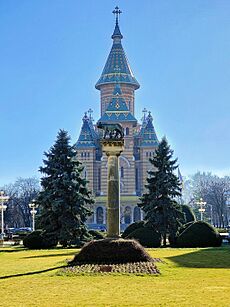
Romania is a secular state, meaning it has no official state religion. Most people identify as Christians. In the 2021 census, 73.86% said they were Orthodox Christians. Of these, 73.42% belong to the Romanian Orthodox Church. Other Christian groups include Protestants (6.22%), Roman Catholics (3.89%), and Greek Catholics (0.61%).
About 128,291 people belong to other Christian groups or other religions. This includes 58,335 Muslims (mostly Turkish and Tatar) and 2,707 Jewish people. (Jews used to be 4% of Romania's population in 1930). Additionally, 71,417 people have no religion, 57,205 are atheists, 25,485 are agnostics, and 2,895,539 people chose not to state their religion.
The Romanian Orthodox Church is an independent Eastern Orthodox Church. It is in full agreement with other Orthodox churches. Its leader is the Patriarch. It is the third-largest Eastern Orthodox Church in the world. Unlike other Orthodox churches, it uses a Romance language for its services. Its religious authority covers Romania and Moldova. Romania has the world's third-largest Eastern Orthodox population.
Urbanization and Cities
Although 54.0% of the population lived in urban areas in 2011, this number has been going down since 1996. Counties with over two-thirds urban population include Hunedoara, Brașov, and Constanța. Those with less than a third are Dâmbovița (30.06%), Giurgiu, and Teleorman.
Bucharest is the capital and largest city in Romania. It had over 1.7 million people in 2021. Its larger urban area has almost 2.2 million people. This area is planned to become a metropolitan area up to 20 times the size of the city itself.
Another 17 cities have over 100,000 people. Cluj-Napoca, Iași, Constanța, and Timișoara have more than 250,000 residents. Craiova, Brașov, and Galați have over 200,000 residents. Metropolitan areas have been created for most of these cities.
|
Largest cities in Romania
2021 Census |
||
|---|---|---|
| Rank | Name | Pop. |
| 1 | Bucharest | 1,716,961 |
| 2 | Cluj-Napoca | 286,598 |
| 3 | Iași | 271,692 |
| 4 | Constanța | 263,688 |
| 5 | Timișoara | 250,849 |
| 6 | Brașov | 237,589 |
| 7 | Craiova | 234,140 |
| 8 | Galați | 217,851 |
| 9 | Oradea | 183,105 |
| 10 | Ploiești | 180,540 |
Education System in Romania
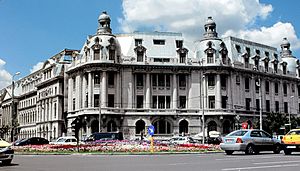
Since the 1989 Romanian Revolution, the education system has been changing. These changes have received mixed reviews. In 2004, about 4.4 million people were in school. Of these, 650,000 were in kindergarten (ages three to six). 3.11 million were in primary and secondary school. 650,000 were in universities. In 2018, 98.8% of adults could read and write.
Kindergarten is optional for ages three to five. Since 2020, schooling is required starting at age five (the last year of kindergarten). It is compulsory until twelfth grade. Primary and secondary education has 12 or 13 grades. There is also an informal private tutoring system. This was popular during the Communist era.
Alexandru Ioan Cuza University of Iași, Babeș-Bolyai University of Cluj-Napoca, University of Bucharest, and West University of Timișoara are among the top 800 universities in the world.
Romania ranks fifth in total medals at the International Mathematical Olympiad. It has 316 medals since 1959. Ciprian Manolescu achieved a perfect score three times. Romania has the highest team score in the competition after China, Russia, the United States, and Hungary. Romania also ranks sixth in total medals at the International Olympiad in Informatics with 107 medals since 1989.
Healthcare Services in Romania
Romania has a universal health care system. The government spends about 5% of its GDP on healthcare. This covers medical exams, surgeries, and post-operative care. It also provides free or subsidized medicine for many diseases. The state must fund public hospitals and clinics. The most common causes of death are heart diseases and cancer. Transmissible diseases are quite common compared to other European countries.
In 2010, Romania had 428 state and 25 private hospitals. There were 6.2 hospital beds per 1,000 people. Over 200,000 medical staff worked there, including over 52,000 doctors. As of 2013, 9% of doctors left the country. This is higher than the European average of 2.5%.
Culture of Romania
Arts and Monuments in Romania
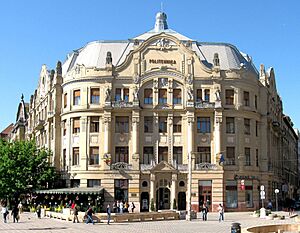
Discussions about the origin of Romanian culture began in the late 18th century. Many writers became famous in the 19th century. These included George Coșbuc, Ioan Slavici, Mihail Kogălniceanu, and Mihai Eminescu. Eminescu is seen as the greatest Romanian poet, especially for his poem Luceafărul.
In the 20th century, several Romanian artists and writers gained international fame. These include Tristan Tzara, Mircea Eliade, Eugène Ionesco, and Constantin Brâncuși. Brâncuși has a sculpture group in Târgu Jiu. His sculpture Bird in Space sold for $27.5 million in 2005. Elie Wiesel, a Holocaust survivor born in Romania, won the Nobel Peace Prize in 1986. Herta Müller, a writer from Romania, won the 2009 Nobel Prize in Literature.
Famous Romanian painters include Nicolae Grigorescu and Ștefan Luchian. Important Romanian classical composers of the 19th and 20th centuries include Ciprian Porumbescu and George Enescu. The annual George Enescu Festival is held in Bucharest to honor Enescu.
Modern musicians like Angela Gheorghiu, Gheorghe Zamfir, Inna, and Alexandra Stan are known worldwide. From the late 2000s to early 2010s, Romanian pop music became popular internationally. Romanian singers placed third at the Eurovision Song Contest in 2005 and 2010.
In cinema, several movies from the Romanian New Wave have won international awards. The Death of Mr. Lazarescu by Cristi Puiu won an award at the Cannes Film Festival in 2005. 4 Months, 3 Weeks and 2 Days by Cristian Mungiu won the top prize, the Palme d'Or, in 2007. Child's Pose by Călin Peter Netzer won the Golden Bear at the Berlin Film Festival in 2013.
Romania has six cultural sites on the World Heritage List. These include eight painted churches of northern Moldavia, eight wooden churches of Maramureș, and seven villages with fortified churches in Transylvania. Also on the list are the Horezu Monastery and the Historic Centre of Sighișoara. The city of Sibiu was the 2007 European Capital of Culture and the 2019 European Region of Gastronomy. Many castles exist in Romania, like Peleș Castle, Corvin Castle, and Bran Castle ("Dracula's Castle").
Holidays, Traditions, and Food
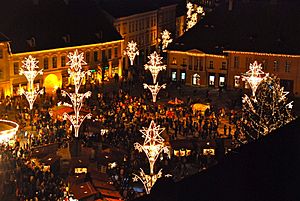
Romania has 12 public holidays when people do not work. One is Great Union Day on 1 December. This day celebrates the 1918 union of Transylvania with Romania. Winter holidays include Christmas and New Year. During this time, unique folk dances and games are common, such as plugușorul and sorcova. Traditional Romanian clothing is often worn during these celebrations, especially in rural areas.
Romanian food has been influenced by Austrian and German cooking. It also shares similarities with Greek, Bulgarian, and Serbian food. Ciorbă includes many kinds of sour soups. Mititei, mămăligă (like polenta), and sarmale are common main dishes.
Pork, chicken, and beef are popular meats. Lamb and fish are also eaten a lot. Some traditional recipes are made for holidays. Chiftele, tobă, and tochitură are for Christmas. Drob, pască, and cozonac are for Easter and other holidays. Țuică is a strong plum brandy. It is Romania's traditional alcoholic drink. Romania is one of the largest plum producers in the world. Other traditional drinks include wine, rachiu, palincă, and vișinată. But beer drinking has increased a lot recently.
Sports in Romania
Football is the most popular sport in Romania. As of 2018, over 219,000 players were registered. The professional football market in Romania is about €740 million. The Romanian Football Federation governs the sport. The Romania national football team played its first match in 1922. It is one of only four national teams to play in the first three FIFA World Cups. It has played in seven World Cups in total. Its best period was in the 1990s, finishing 6th at the 1994 FIFA World Cup. FIFA ranked it 3rd in 1997.
The main player of this "golden generation" was Gheorghe Hagi, nicknamed "Maradona of the Carpathians." Other successful players include Dudu Georgescu and Simona Halep. Romania's home stadium is the Arena Națională in Bucharest.
The most successful club is Steaua București. They were the first Eastern European team to win the UEFA Champions League in 1986. Dinamo București reached the UEFA Champions League semi-final in 1984.
Tennis is the second most popular sport. Romania reached the Davis Cup finals three times. In singles, Ilie Năstase was the first World Number 1 in 1973. He won several Grand Slam titles. Virginia Ruzici won the French Open in 1978. Simona Halep won the French Open in 2018 and Wimbledon in 2019. She was WTA's World Number 1 in 2017 and 2018. In doubles, Horia Tecău won three Grand Slams.
The second most popular team sport is handball. The men's team won the handball world championship four times. This makes them the third most successful nation ever. The women's team won the world championship in 1962. They have been more successful recently. Romanian club teams have won the EHF Champions League three times. Notable players include Ștefan Birtalan and Cristina Neagu. Cristina Neagu has won the IHF World Player of the Year award four times.
Popular individual sports include combat sports, martial arts, and swimming. In professional boxing, Romania has produced many world champions. These include Lucian Bute and Leonard Dorin Doroftei. Professional kickboxing has also produced famous fighters like Daniel Ghiță.
Romania has won 306 Summer Olympics medals. This ranks them 12th among all countries. Their 89 gold medals rank 14th. The 1984 Summer Olympics was their most successful. They won 53 medals, including 20 gold, placing 2nd in the medal rankings. Among countries that have never hosted the Olympics, they are second in total medals.
Gymnastics is Romania's main medal-winning sport. Olympic icon Nadia Comăneci was the first gymnast to score a perfect ten at the 1976 Summer Olympics. Other Romanian athletes who won five gold medals are rowers Elisabeta Lipa and Georgeta Damian. Romanians have also won gold medals in athletics, canoeing, wrestling, shooting, fencing, swimming, weightlifting, boxing, and judo.
Images for kids
-
Three Chalcolithic ceramic vessels (from left to right): a bowl on stand, a vessel on stand and an amphora, ca. 4300–4000 BC; from Scânteia, Romania and displayed at the Moldavia National Museum Complex
Related pages
- Communes of Romania
- Counties of Romania
- List of cities in Romania
- List of lakes of Romania
- List of Romanian writers
- Municipalities of Romania
- Romania at the Olympics
- Romania national football team
See also
 In Spanish: Rumania para niños
In Spanish: Rumania para niños




